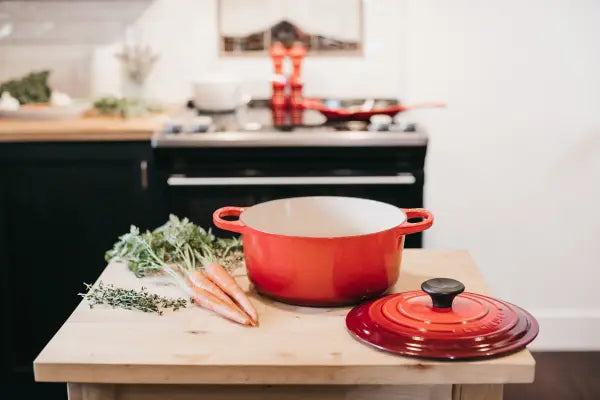How Sensory Play Helps Infants Build Confidence, Skills, and Joy Around Food
Starting solids isn’t just about nutrition, it’s the beginning of a whole new sensory world for your baby. Each taste, texture, smell, sound, and colorful bite offers a chance for exploration, development, and connection. From the squish of avocado to the snap of a green bean, these little sensory moments build big skills.
Learning to eat is a full-brain experience. That’s why engaging all your baby’s senses during mealtimes can support more than just eating. It can also foster oral-motor coordination, reduce picky eating, encourage communication, and help babies feel confident and curious around food.
To explore why this matters and how to do it, we brought together insights from two pediatric experts: a speech-language pathologist and a registered dietitian. Together, they break down how sensory exposure supports everything from chewing and talking to trying new foods with confidence.
Why sensory play supports babies learning to eat

How food exploration builds chewing and oral skills
Sensory exposure is an amazing opportunity to help support your little one’s oral motor development. As your child experiences new textures and tastes in their mouth, they learn how to coordinate their oral motor movements with increasing efficiency and skill. This also helps to prevent oral defensiveness and sensitivity later in life.
Offering a variety of textures, from purees to crunchy solids, teaches babies that different foods require different oral motor strategies. It gives them the opportunity to develop new skills, like more complex chewing, when they are offered a wide range of textures rather than just the same texture repeatedly that they have already mastered. Research shows us that oral development is dependent on specific chewing opportunities that are offered to a child at appropriate ages.
When babies experience harder-to-chew textures early, between 6 and 18 months, they:
-
Develop a preference for more complex textures
-
Build stronger oral coordination
-
Are more likely to accept challenging foods later in life
-
Help to prevent or desensitize aversions and build tolerance to new stimulation
-
For example, "lumpy" purees between 6 and 9 months can help desensitize the gag reflex and reduce aversions
💬 Chewing is learning. Sensory-rich foods help babies build the muscle coordination they’ll use for eating, speaking, and beyond.

Can sensory play prevent picky eating in infants?
Early exposure builds familiarity with textures, smells, and flavors
Early exposure to a variety of sensory experiences like different textures, colors, smells, and temperatures, can help babies become more adaptable and accepting eaters over time. From a dietitian’s perspective, this kind of exposure lays the foundation for a positive, curious relationship with food and helps reduce the likelihood of picky eating down the road.
There is research to show that flavors introduced in utero can influence someone’s flavor preferences later in life. And, as was mentioned in the previous section, there is a window to learn the skills to handle more complex textures. Delayed exposure to advancing textures may contribute to picky eating or acceptance of important foods like fruits, vegetables, and protein foods.
Introducing a wide range of sensations helps babies learn that food comes in many forms. The more regularly babies encounter these differences, the more they build familiarity and comfort with them. Examples of sensory-rich foods to try with your baby:
- Cool yogurt
- Warm oatmeal
- Squishy avocado
- Crunchy toast
It’s not about pressuring them to like every food, but about offering safe, consistent chances to explore and engage. Even if your baby doesn’t eat a new food right away, touching, smelling, and playing with it still counts as valuable sensory learning. Over time, that exposure can make them more likely to try and accept a broader range of foods. If you have been in the groove of feeding purees and now want to mix it up, we have ideas on taking purees and turning them into finger foods, which is a great way to branch out with textures.
💡 Messy now, less picky later. Sensory play at mealtimes can lead to more flexible, adventurous eating habits as your baby grows.
How food play helps babies develop early language skills
Encouraging words, signs, and social interaction during meals
Sensory food exposure contributes to communication development by providing natural opportunities for interaction, language use and social engagement.
As babies explore foods, they:
- Practice first signs and words like “more” and “all done”
- Learn descriptive language (hot, cold, crunchy, sweet, sour)
- Engage in turn-taking and social routines (passing spoons, shared smells)
- Begin understanding cause and effect (dropping food = fun reaction)
Caregivers can reinforce these moments by:
- Narrating the eating experience
- Labeling sensory experiences as they happen
- Offering repeated, low-pressure opportunities to use new words
🗣 Every bite is a chance to connect. Sensory play at mealtimes opens the door to early communication and rich language learning.

Building a positive relationship with food from the start
Mealtimes are about more than just nutrients, they’re a chance to build trust, curiosity, and connection around food. When babies are encouraged to explore with all their senses: touching, smelling, listening, observing, and tasting, they’re not just learning what food is, but how to enjoy it.
Sensory-rich mealtime experiences help babies become:
- More confident and curious eaters
- Less pressured to perform at the table
- More likely to build positive associations with food
Examples of sensory experiences that encourage curiosity:
- Squishing mashed peas
- Smelling a warm spoonful of cinnamon applesauce
- Listening to a crunchy toast bite
Creating a low-stress, exploratory environment helps set the tone for future mealtimes too. Research shows that babies who are offered foods in a responsive, child-led way are more likely to maintain healthy eating habits and experience fewer mealtime battles later on.
🎨 Engagement over perfection. When babies are invited to explore food with their senses, they’re more likely to approach eating with curiosity instead of caution.
How to engage all five senses during mealtimes
Touch: let baby explore with their hands

- Let baby self-feed! Use soft, firm, dry, wet, sticky and crunchy textures.
- If they’re apprehensive about touching a new texture, encourage them to feed you or a toy—model touching the food in front of them.
- Food examples to try: banana with skin, pasta, fork-mashed sweet potato or avocado, spoonfuls of puree on the tray, cereal and teething crackers.
Sight: invite curiosity with colorful, playful plates

- Offer colorful plates with contrasting colors and shapes.
- Try rainbow meals by offering foods of different colors alongside each other.
- Arrange food into simple shapes or patterns to catch baby’s eye.
Smell: let baby sniff and explore aromas

- Use a variety of smells, such as basil, cinnamon, and garlic.
- Let your baby smell straight from spice jars while you cook.
- Show them how to smell and take turns before tasting—it helps engage their brain.
Taste: help baby learn to love new flavor

- Offer a range of flavors: bitter greens, sour fruits, umami-rich foods (like mushrooms or parmesan), semi-spicy meats, sweet and salty items.
- If your baby seems sensitive, start with small amounts and build gradually.
- Introduce new foods regularly to build comfort and acceptance.
Sound: help baby hear the joy in eating

- Show babies how food sounds! Drop food on the tray to hear it “plop,” or break a green bean near their ear.
- Describe textures as you eat them - Chew loudly and say words like “crunch crunch.”
- Describe the flavors of foods that you are trying to teach - “These strawberries are sweet”
Parent tips to make sensory food play easy and stress-free
Don’t Wipe Too Soon- embrace messiness as part of learning
Messiness is part of sensory learning! And if mess makes you uncomfortable - stay tuned, as another blog is coming soon on how to embrace mess on your own terms.
Follow Your Baby’s Lead
- Look for signs of readiness, interest, or overwhelm.
- Model Enthusiasm at Mealtimes
Babies mirror joy and curiosity, so you can teach them to love food by enjoying your shared meals. This means prioritizing sitting down and eating with them when possible.
Narrate Your Experience
Describe what you’re seeing, smelling, and tasting to build your baby’s vocabulary.
Play with food
Food can be used for more than just eating in a highchair! Feel free to engage your little one with food in different ways, especially if you think they are apprehensive!
- Hide teethers or toys in soft foods, like pasta or rice to encourage digging.
- On warm days, take frozen fruits or veggies outside and feel them melt.
- Explore float/sink play with foods in bowls of water.
Start with senses, grow with confidence
Every squish, sniff, taste, and giggle at the highchair is more than just a mess—it’s learning in action. Sensory play during mealtimes supports so many essential skills: eating, speaking, social connection, and curiosity. It’s not about doing it perfectly, or following a set of rigid rules—it’s about tuning in to your baby, offering variety, and making space for joyful exploration.
Whether you’re diving into baby-led weaning, using purees, or trying a little of everything, know that engaging your baby’s senses is a powerful and playful way to support their development.
You’ve got this—and we’re here with you for every sticky, crunchy, colorful bite.

Written by Lauren Remondino, MS, CCC-SLP, CLC
Feeding Therapist, Speech Language Pathologist, Lactation Counselor & Advisor at Bébé Foodie
Lauren Remondino is a pediatric feeding specialist and mom, with a background in speech-language pathology and lactation counseling. After years working in top children’s hospitals, she now brings her clinical expertise—and real-life parenting perspective—to Bébé Foodie. Lauren works closely on developing our How to Serve guides and feeding support content, helping parents feel confident at every stage of their baby’s food journey. She’s all about keeping things realistic, flexible, and supportive—because feeding isn’t one-size-fits-all, especially when you’re juggling nap schedules and snack requests.

Written by Jenny Janov, MPH, RD
Pediatric Dietitian & Advisor at Bébé Foodie
Jenny is a Registered Dietitian Nutritionist with over 15 years of experience, specializing in pediatrics. She studied nutrition at UNC Chapel Hill and worked in hospitals and clinics across California, including UCSF and Stanford. Passionate about helping families, she guides them in making positive nutrition choices and setting achievable goals. As Bébé Foodie’s pediatric dietitian, she helps create expert-backed guidance for parents navigating their child's food journey. Now based in Bend, OR, she enjoys the outdoors, running, snowboarding, paddleboarding, cooking, and time with her husband and two boys.





Leave a comment